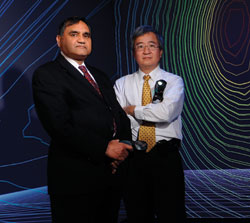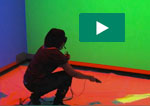UAB Engineers Push the Boundaries of 3-D Technology
By Grant Martin
 |
Bharat Soni and Alan Shih are exploring uses for UAB's 3D visualization technology in a wide range of fields, including rehabilitation, medical training, and homeland security. |
Imagine a place where amputees can learn to ski without risking serious injury; where bomb squads can disarm explosive devices with no chance of casualties; and where surgeons can make perfect incisions and perform flawless operations—before they ever touch a patient.
Researchers in the UAB School of Engineering’s Enabling Technology Laboratory have assembled just such a facility—a virtual-reality environment that can be used for a host of creative applications. This “visualization cube” is the latest expansion of the school’s computer imaging and simulation capabilities, and it could lead to revolutionary advances in a host of fields, including engineering, medicine, rehabilitation, emergency management, and education.
The facility—which was made possible by financial support from the schools of Engineering and Health Professions and the State of Alabama—immerses the user in a virtual environment that is remarkably realistic, says Bharat Soni, Ph.D., chair of the Department of Mechanical Engineering. “At UAB, we’re using this technology mostly for engineering and health-care applications, but the possibilities really are endless.”
The Virtual Patient
To demonstrate his point, Soni shows images of CT and MRI scans on the 3-D screen in the school’s Enabling Technology Laboratory. A life-size image of a human pelvis rotates on the screen, turning 360 degrees to allow the viewer to examine it from every angle. Such images provide more information than the standard two-dimensional versions; but when projected in a visualization cube, they could offer an even more immersive environment.
Soni says he envisions a future where doctors can use this visualization technology—along with “haptic” devices that add the element of touch—to improve their real-world skills. “One of our goals is to one day allow surgeons to conduct critical procedures in a virtual environment so that they can see exactly what issues might arise,” says Soni. “They can get all the kinks out before they ever enter an operating room.”
The technology could also be used in the classroom, where virtual patients could reduce the need for cadavers in medical schools. “The savings in time and expenses would be tremendous,” Soni says. “Imagine how much more efficiently students could be trained by performing procedures in this environment.”
From Simulation to Rehabilitation
Computer-based visualization and simulation have long been strengths of the School of Engineering. When Soni arrived at UAB in 2002, he established the Enabling Technology Lab, which utilizes both 3-D and high-definition visualization technologies. The lab, directed by mechanical engineering professor Alan Shih, Ph.D., can simulate and visualize wind currents through cities, blood flow through arteries, and air flow around a car or airplane.
As advanced and informative as these simulations are, however, they are only images. The new visualization cube will help bridge the gulf between simulation and real-world application by adding an immersive component.
Soni’s team is exploring collaborations with the School of Health Professions and Birmingham’s Lakeshore Foundation to allow patients to perform rehabilitation activities in the controlled environment of the visualization cube. For example, amputees are often taught to water ski as part of their therapy in order to strengthen the necessary muscles and improve their balance. For such patients, the cube can become a lake, and with the help of haptic and other devices, they can experience virtual waterskiing with minimal risk.
The cube also will allow therapists to closely monitor patients and might even be a useful environment for gait analysis and other tests, Soni says. “It also gives the patients the feeling of actually participating in these activities. It allows them to build confidence and a comfort level that is very important to rehabilitation.”
Playing Catch-Up
As rapidly as 3-D technology is being applied to areas such as medicine and education, it is the entertainment industry that’s moving fastest to push the technology into wide-scale use, Soni says. Just last year, the University of Florida filmed a football game in 3-D, he says. “Of course, viewers had to wear glasses to get the 3-D effect, but if you have seen it once, you will never want to watch another game on a two-dimensional screen.”
“There were 15 movies scheduled to come out in 2009 that were available in 3-D,” Soni adds. And major electronics makers are already producing 3-D televisions, “so the entertainment industry is definitely a step ahead in getting the technology out there.”
Given the everyday exposure of children to the excitement of 3-D entertainment, Soni says it’s a shame that schools are teaching only from textbooks and using the same methods that were established decades ago. “We need to find new ways to incorporate technology into education,” he says. “At UAB we’re already using simple simulations to introduce high school students to engineering concepts, but we need to get more of those types of innovations into the classroom.”
Education and training, medicine, homeland security, rehabilitation—these are just a few of the areas where Soni believes 3-D visualization technology has the power to greatly enhance safety, efficiency, and fun.
